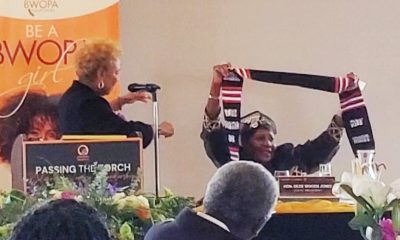Bay Area
Alameda County Sheriff Greg Ahern Lost Re-Election: But Mailer Falsely Invoking Latino Voice Bears Watching
Traditionally, PACs form to support a candidate with more money than allowed by the conventional political contribution means. It seems the group called United Latinos Vote (ULV) was created with the intention of not only donating thousands of dollars to the Ahern’s re-election but also falsely insinuating that the money came from Latinos.

By Mariano Contreras
The results of the June 7 primary election sent a message to Sheriff Gregory Ahern: Alameda County residents wanted change and desired reform. Candidate Yesenia Sanchez, although outspent by Ahern, received 52.05% to his 32.28% of the vote and will now be Alameda County’s new sheriff.
But the contest gave rise to a disingenuous new Political Action Committee (PAC) that worked for the re-election of Ahern. On May 10, a group called United Latinos Vote (ULV) spent $40,000 on a mailer supporting Ahern’s re-election. The Oakland Police Officers Association (OPOA) contributed $25,000, making them the largest donor to this PAC.
Traditionally, PACs form to support a candidate with more money than allowed by the conventional political contribution means. It seems ULV was created with the intention of not only donating thousands of dollars to the Ahern’s re-election but also falsely insinuating that the money came from Latinos.
But investigation shows that the ULV PAC has no record of ever speaking in favor or against police reform in Oakland or supporting any other local and/or Latino campaigns.
Safe neighborhoods, peaceful streets, and accountable police departments have always been priorities for Oakland Latinos. In pursuing public safety, we have also presented a diverse spectrum of sentiments and ideas based on principle and truth.
Since the early 1970s, numerous Oakland Latino groups have been actively involved in supporting campaigns that reflected our concerns and interests. Many times, while volunteering our time to campaign, we were successful in including our issues on candidates’ platforms.
As a result, we formed advocacy groups made up of longtime activists and initiated candidate forums that spoke to our Latino community. The Latino Task Force began out of this effort, and we have involved ourselves in every election cycle since the 2016 general election. We have a history and connection to Oakland.
What has ULV done in Alameda County? What have they done in Oakland?
Alameda County’s Latino population borders 23% and, by many accounts, was not friendly to an Ahern re-election. It was most opportune and worrisome that a “Latino” PAC accepted money from a group blind to Latino issues when a formidable and qualified Latina candidate decided to run for sheriff.
The OPOA has never shown any interest in addressing issues important to Latino officers such as the lack of high-ranking Latino officers or the disproportionate discipline of Latino officers in the Oakland Police Department.
Now OPOA wanted to conveniently ally itself with a new and suspect Latino group that ignores many years of opposition to the broken, heavy-handed Sheriff’s Department and the brutal mismanagement of the county’s Santa Rita Jail.
We reject this devious and failed attempt at misleading the Latino electorate! Our effort to engage our community should be grounded in trust, involvement, and knowledge of our issues, not opportunistic gamesmanship.
Mariano Contreras is a member of the Latino Task Force.
Alameda County
Seth Curry Makes Impressive Debut with the Golden State Warriors
Seth looked comfortable in his new uniform, seamlessly fitting into the Warriors’ offensive and defensive system. He finished the night with an impressive 14 points, becoming one of the team’s top scorers for the game. Seth’s points came in a variety of ways – floaters, spot-up three-pointers, mid-range jumpers, and a handful of aggressive drives that kept the Oklahoma City Thunder defense on its heels.

By Y’Anad Burrell
Tuesday night was anything but ordinary for fans in San Francisco as Seth Curry made his highly anticipated debut as a new member of the Golden State Warriors. Seth didn’t disappoint, delivering a performance that not only showcased his scoring ability but also demonstrated his added value to the team.
At 35, the 12-year NBA veteran on Monday signed a contract to play with the Warriors for the rest of the season.
Seth looked comfortable in his new uniform, seamlessly fitting into the Warriors’ offensive and defensive system. He finished the night with an impressive 14 points, becoming one of the team’s top scorers for the game. Seth’s points came in a variety of ways – floaters, spot-up three-pointers, mid-range jumpers, and a handful of aggressive drives that kept the Oklahoma City Thunder defense on its heels.
One of the most memorable moments of the evening came before Seth even scored his first points. As he checked into the game, the Chase Center erupted into applause, with fans rising to their feet to give the newest Warrior a standing ovation.
The crowd’s reaction was a testament not only to Seth’s reputation as a sharpshooter but also to the excitement he brings to the Warriors. It was clear that fans quickly embraced Seth as one of their own, eager to see what he could bring to the team’s championship aspirations.
Warriors’ superstar Steph Curry – Seth’s brother – did not play due to an injury. One could only imagine what it would be like if the Curry brothers were on the court together. Magic in the making.
Seth’s debut proved to be a turning point for the Warriors. Not only did he contribute on the scoreboard, but he also brought a sense of confidence and composure to the floor.
While their loss last night, OKC 124 – GSW 112, Seth’s impact was a game-changer and there’s more yet to come. Beyond statistics, it was clear that Seth’s presence elevated the team’s performance, giving the Warriors a new force as they look to make a deep playoff run.
Activism
Oakland Post: Week of November 26 – December 2, 2025
The printed Weekly Edition of the Oakland Post: Week of November 26 – December 2, 2025

To enlarge your view of this issue, use the slider, magnifying glass icon or full page icon in the lower right corner of the browser window.
Activism
Oakland Post: Week of November 19 – 25, 2025
The printed Weekly Edition of the Oakland Post: Week of November 19 – 25, 2025

To enlarge your view of this issue, use the slider, magnifying glass icon or full page icon in the lower right corner of the browser window.
-

 Activism3 weeks ago
Activism3 weeks agoOakland Post: Week of November 12 – 18, 2025
-

 Activism4 weeks ago
Activism4 weeks agoOakland Post: Week of November 5 – 11, 2025
-

 Activism2 weeks ago
Activism2 weeks agoIN MEMORIAM: William ‘Bill’ Patterson, 94
-

 Activism3 weeks ago
Activism3 weeks agoHow Charles R. Drew University Navigated More Than $20 Million in Fed Cuts – Still Prioritizing Students and Community Health
-

 Bay Area3 weeks ago
Bay Area3 weeks agoNo Justice in the Justice System
-

 #NNPA BlackPress3 weeks ago
#NNPA BlackPress3 weeks agoThe Perfumed Hand of Hypocrisy: Trump Hosted Former Terror Suspect While America Condemns a Muslim Mayor
-

 #NNPA BlackPress2 weeks ago
#NNPA BlackPress2 weeks agoTrump’s Death Threat Rhetoric Sends Nation into Crisis
-

 #NNPA BlackPress3 weeks ago
#NNPA BlackPress3 weeks agoProtecting Pedophiles: The GOP’s Warped Crusade Against Its Own Lies

























































